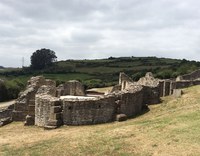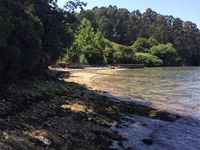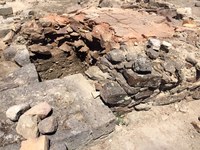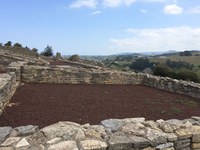Visualizing Medieval Spanish Society
Visualizing the Collapse of the Roman Empire and the Emergence of the Bishop’s Power in Medieval Spanish Society
Project director: Rebecca A. Devlin
Abstract
This project uses digital mapping and data visualization technology to better understand the dynamic processes by which bishops and the Church gained social, political and economic power in late Roman and Early Medieval Spain and Portugal.
Full Project Description
Prior to the conversion of the Roman emperor Constantine to Christianity in the early fourth century, the influence of bishops was limited to guiding congregations on the margins of Roman society. Yet, by the Early Middle Ages ecclesiastical leaders acted as judges and diplomats, controlled large plots of land and managed substantial numbers of slaves. This project will use digital mapping and data visualization technology to better understand the dynamic social and economic processes by with this transformation took place in Gallaecia, a former Roman Province in modern northwestern Spain and Portugal.
While this digital mapping project is in its early stages, it builds on the research conducted for Dr. Devlin's doctoral dissertation and current book project, "Bishops and Community in Northwestern Hispania: Transforming Roman Society, ca. 370 to 470 C.E.". This larger project uses textual and archaeological sources to create microhistories that place specific clerical groups in their larger social and economic contexts at different chronological points to show how and why their influence expanded within their local communities.
In particular, rural and urban settlement features—such as domestic spaces, markets, and churches—have been traced to show how they changed over time. For example, in the city of Braga, Portugal, the Roman amphitheater was an important and centrally located Roman institution that brought members of the community from every level of society together. The monumental structure slowly went into disuse over the course of the third and fourth centuries, and then became a site for industrial production and low-status housing beginning in the fifth century. In another example, a market on the outskirts of the city was converted into a church in the early fifth-century and with time the urban landscape transformed so that the ecclesiastical complex became the new center of the community. Many changes happened in the rural setting as well. For example, while some elite Roman villas in Spain and Portugal were completely abandoned shortly after the collapse of the western empire, many—such as Veranes outside of Gijón—slowly transformed into cemeteries and then rural churches. There are no written sources documenting any of these changes, so the archaeological evidence is essential to understanding the shifts in communal organization and social and economic landscapes and the dynamic processes involved.

Remains of the dining hall of the Roman Villa Veranes, which was transformed into a church in the Early Middle Ages.
Since material culture, like texts, are actively and meaningfully constituted and used in social relationships, analyzing the spatial arrangement of settlement features and how they changed, provides insight into historical communities and the social relations within them (Halsall, Hamerow, Moreland). Yet, as John C. Barrett has argued monuments and structures do not merely represent certain social conditions. Instead it is through their construction that those conditions are gradually transformed. People encounter a place having accumulated their own biographical experiences. The place has its own traditions and conventions and those that arrive contribute their own practices. Therefore, "each generation can be regarded as having to confront its own archaeology as the material remains of its past piled up before it" (Barrett, 257). The act of inhabiting a place is meaningful to the inhabitants according to their own experiences and desires, but becomes socially meaningful when their actions are set into a widely accepted frame of reference. This makes viewing each stage of a transformation within its own context crucial to understanding social change.

Remains of the Roman Villa Noville outside of Mugardos, Spain, showing how currently it is largely under water.
Viewing settlements and buildings in their specific contexts can be difficult. The manner in which they are excavated often means that they are presented in terms of their stratigraphic levels, which tends to reduce the spaces that were inhabited by human actors into mere phases. Moreover, many of these spaces are no longer visible because they have not been fully excavated, are beneath modern structures or in the case of coastal settlements, they have become submerged under water. Digital mapping and data visualization can help us to see how different people confronted their landscapes and then accommodated them, thus providing insight into how through inhabiting places individuals and groups created and transformed the social and economic dynamics of their communities. Furthermore, digital mapping and visualization facilitates analysis of each phase of a building or settlement in its own particular context. Finally, including data related to all levels of society—from the elite to artisans, free servants and slaves—makes it possible to more fully understand the transformations that happened, since they each would have been active participants in the processes that contributed to the growing influence of bishops and the church in local communities.
Works Cited
Barrett, John C. “The Mythical Landscapes of the British Iron Age.” In Archaeologies of Landscape: Contemporary Perspectives, edited by Wendy Ashmore and A. Bernard Knapp. Malden, MA: Blackwell, 1999, 253-265.
Halsall, Guy. Cemeteries and Society in Merovingian Gaul: Selected Studies in History and Archaeology, 1992-2009. Leiden: Brill, 2010.
Hamerow, Helena. Early Medieval Settlements. The Archaeology of Rural Communities in North-West Europe, 400-900. Oxford: Oxford University Press, 2002.
Moreland, John. Archaeology, Theory and the Middle Ages: Understanding the Early Medieval Past. London: Duckworth, 2010.


